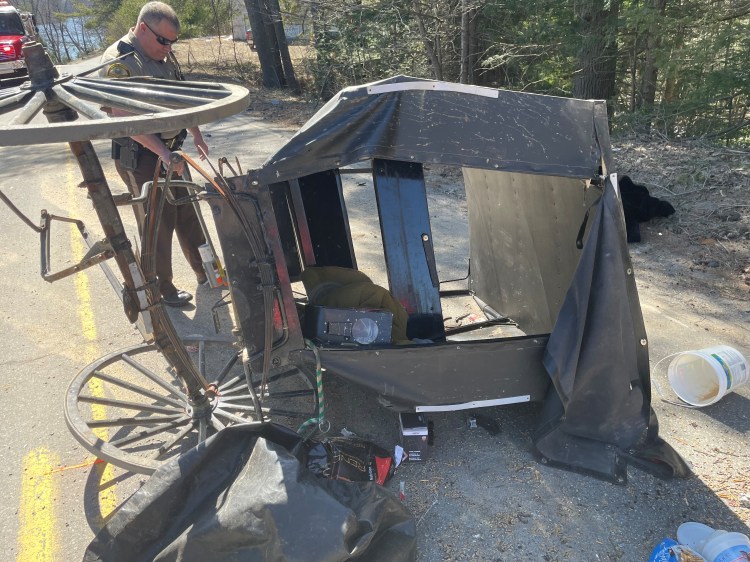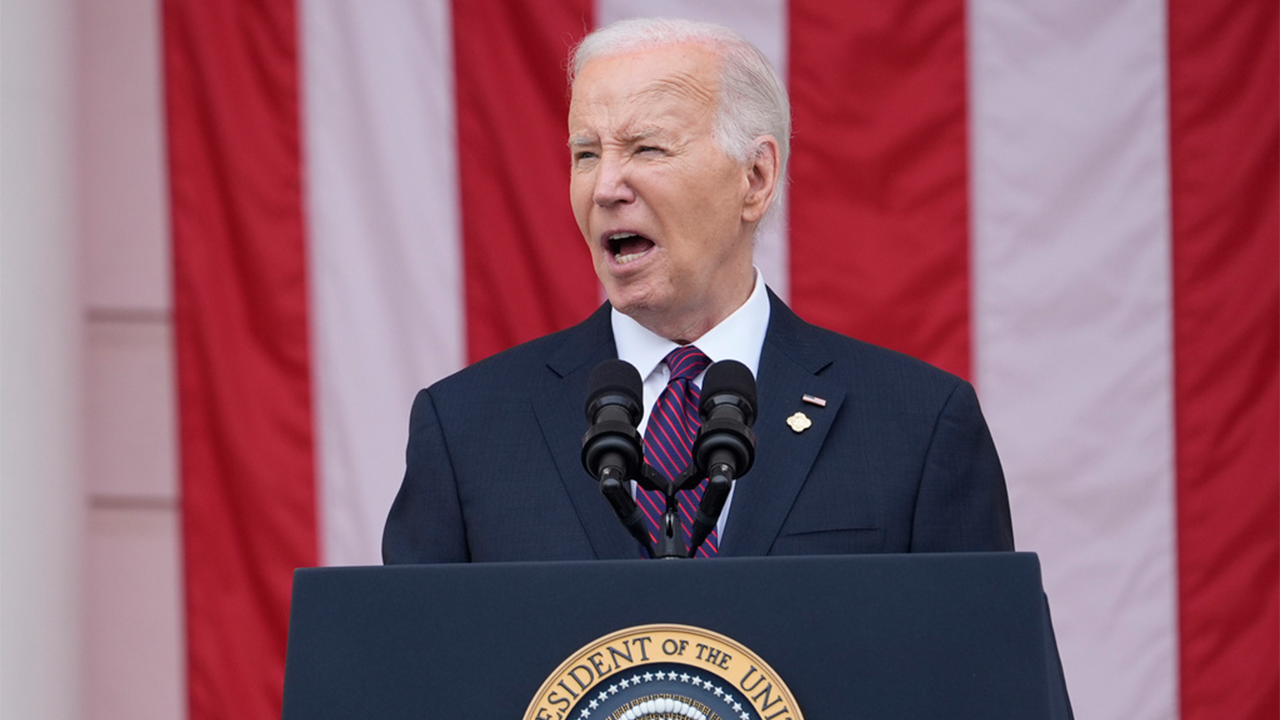
A horse-drawn carriage is pictured following a crash on River Road in Norridgewock in April. Police say both the horse and driver of the carriage were injured when a driver attempted to pass them. As carriages become more common in parts of the state, driver’s education instructors say they are putting more emphasis on how motorists should act around them. Photo courtesy of the Somerset County Sheriff’s Office
Always fasten your seat belt. Keep both hands on the steering wheel. And when you see a horse-drawn carriage, remember that it has as much a right to be on the road as you do.


For young Mainers learning how to drive in areas of the state where horse-drawn buggies are a common sight, educators have been putting more emphasis on the right way for motorists to act.
The goal is to give students the tools they need to stay safe when their 200-horsepower vehicle comes up on one powered by just one horse — an interaction that happens regularly in Maine communities where Amish people have settled.
“Most of our students, that’s an everyday occurrence, sharing the road with Amish people,” said Chuck Penney of Coastal Driving Academy, who teaches a class at Mt. View High School in Thorndike, not far from an Amish settlement in Unity.
Instructors say students are taught to slow down when approaching a carriage, and to give the animal and driver plenty of space, recognizing that carriages have vulnerable wheels that stick out. They are told to remember that horses are animals — they spook easily and can be unpredictable.
“They are vehicles in the roadway and they have the same right to the roadway as the motorist does,” said Shenna Bellows, Maine’s secretary of state.
Those are universal lessons given to nearly every driver’s education student through the curriculum developed by AAA.
The lessons come as Amish communities continue to establish in the region, putting more buggies on the same roads as motor vehicles, and sometimes leading to dangerous wrecks.
Just last month in Norridgewock, a 34-year-old Skowhegan woman was charged with driving to endanger, as well as several traffic violations, after police say she crashed her car into a horse-drawn carriage while trying to pass it. Both the horse and the carriage driver suffered injuries.


A sign warning motorists to look out for horse-drawn carriages on Cooper Road in Whitefield. Joe Phelan/Kennebec Journal file
‘TWO LANES AND NO SHOULDER’
In areas like northwestern Waldo County, where drivers are more likely to see a horse-drawn carriage, those lessons are given more emphasis.
Pat Moody of AAA Northern New England likens it to the lesson plan on roundabouts, which may only get a quick mention in some areas. But if you’re talking to students in Augusta, where there are two roundabouts known for their frequent accidents, the instructor will spend more time on it.
It’s important, Moody said, that inexperienced drivers are ready to deal with whatever they encounter on the road. From a distance, particularly at night, a horse-drawn carriage can be hard to make out, or to see altogether, making for some white-knuckle interactions.
“It can definitely be frightening for both,” Moody said.
The interactions don’t always end well. According to data from the Maine Bureau of Highway Safety, there have been 33 collisions between motor vehicles and horse-drawn buggies in Maine in the last decade. One person died and another three had serious injuries. At least two horses have been killed in collisions; in another, an infant was thrown from a buggy.
Not surprisingly, the crashes have been centered in areas of the state where Amish communities have settled, including three in Whitefield in under a month in the summer of 2021.
Amish families first came to Maine in 1996, settling in the Aroostook County town of Smyrna before forming “sister” settlements in Unity and Hodgdon. Another group settled in Fort Fairfield in 2007. Three families from New York and Kentucky came to Whitefield, in Lincoln County, in late 2016.
Now, there are at least 11 Amish communities in Maine, with five more founded in the last five years in rural parts of Somerset, Oxford, Androscoggin and Penobscot counties.
Descended from the Anabaptist movement of the Protestant Reformation in 16th-century Europe, the Amish shun modern technology. They settle in rural farming communities where they can work the land and sell the goods they produce — and where they are able to run errands on horse-drawn carriages.
That’s put them in a very vulnerable position, on tight rural roads next to speeding motor vehicles of all sizes.
“In my district, the roads are winding, two lanes and no shoulder,” then-state Rep. Chloe Maxmin of Nobleboro said in 2019.
Officials have responded with a number of safety measures.
Maxmin was speaking in favor of a bill, ultimately passed into law, that requires buggy operators use reflection tape and lights, or lanterns, to announce their appearance to others on the road — a law that takes into consideration certain religious objections of some Amish communities.
The state has also put up distinctive black-and-yellow signs on many roads warning motorists that horse-drawn carriages may be present.
But the lights and signs won’t mean much if drivers don’t do their part.
‘YOU NEED TO BE PATIENT‘
“Those warning signs are telling you something,” said Penney, the driver’s ed instructor. “You just need to be patient.”
Drivers need to be able to identify a horse-drawn carriage as they approach it, Penney said. They should give the carriage space, and understand the hand signals that buggy drivers use on the road.
After all, when it comes to a carriage, the result of distraction or aggressive driving could be tragic.
“They could be full of hay, or they could be full of a family of children,” Penney said.
As the charges against in Norridgewock collision show, Penney’s instructions are not just good practice; it’s against the law in Maine to knowingly frighten or startle an animal on a public road.
“It’s not a suggestion; it’s the law,” Bellows said.


In June 2023, a driver attempting to pass a horse-drawn carriage on Route 17 in Somerville instead clipped the buggy, detaching one of its wheels. Courtesy of Lincoln County Sheriff’s Office
Ultimately, instructors and officials said, as startling as it can be to come upon a horse, it’s not a whole lot different than other driving situations that require motorists to share the road. For safety, everyone has a role to play.
The people driving the carriage must obey the laws on visibility. Just like pedestrians and bicyclists, they should keep an eye out for traffic, too, understanding that drivers might be surprised to see them, if they see them at all.
And, they said, whether it’s a pedestrian, someone on a bike or motorcycle, or someone in a carriage, driver’s have to be aware of what’s around them. There are too many distractions, with too many drivers impatient to get where they are going.
Everyone, they said, needs to slow down and consider the people around them.
“We need to understand that all these vehicles perform differently,” said Moody. “We all hold that responsibility to share the road.”
« Previous
Next »
Related Stories






























Invalid username/password.
Please check your email to confirm and complete your registration.
Use the form below to reset your password. When you’ve submitted your account email, we will send an email with a reset code.